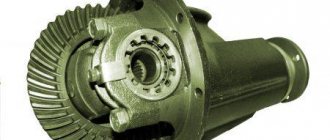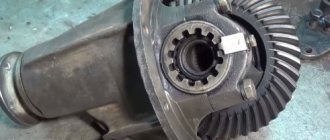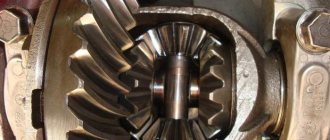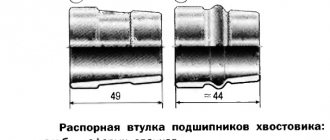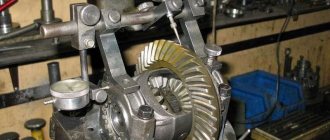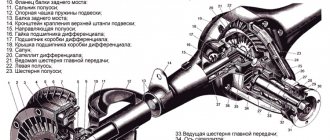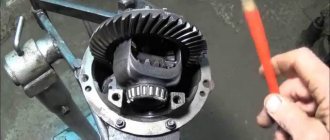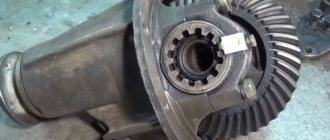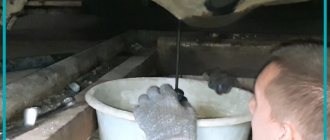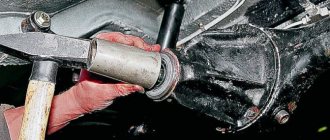A considerable number of owners of classic Zhiguli cars wondered why the rear axle gearbox of the VAZ 2107 and previous models was humming. This unit was expensive at all times, and it is almost impossible to repair it yourself. When the rear of a car howls, all that remains is to clearly diagnose the problem and contact a good technician. And also understand the cause of the breakdown in order to avoid a repetition of the situation in the future.
Why is the rear axle gearbox of the VAZ 2107 humming? Why is the bridge howling?
A considerable number of owners of classic Zhiguli cars wondered why the rear axle gearbox of the VAZ 2107 and previous models was humming. This unit was expensive at all times, and it is almost impossible to repair it yourself. When the rear of a car howls, all that remains is to clearly diagnose the problem and contact a good technician. And also understand the cause of the breakdown in order to avoid a repetition of the situation in the future.
Causes of malfunction
The VAZ 2107 rear axle gearbox is a complex and precise mechanism with a high degree of reliability. Nevertheless, for one car enthusiast it lasts the entire “life” of the car without the slightest problem, while another changes the gearboxes one after another, but the result is still the same. Based on practical observations, it is worth highlighting several reasons for the breakdown of the unit:
- operation of VAZ 2101-07 in extreme mode with overload;
- frequent slipping when moving from a stop;
- strong jerks when towing another car;
- loss of oil and dry driving;
- intervention of incompetent “masters”.
Driving with a heavy load means driving with an overloaded trailer and car. For such car enthusiasts, gearboxes fail very often. The same can be said about extreme sports enthusiasts who love to drive off to the sound of squealing tires. After such loads, the unit can howl at any moment.
The hum of the rear axle gearbox may occur after towing another car, when it needs to be pulled out of some hole or mud. For this reason, the mechanism on the Niva often suffers among fans of extreme off-road driving.
Bearing wear
a) Shank bearings
- As if something was buzzing. Moreover, it buzzes constantly, no matter what mode you move in. During the start and at low speed the buzzing is almost inaudible. But the higher the speed, the more distinct the rumble.
- If you do not pay attention to such sounds for a long time, then over time, when you move at low speed, the sound will become rougher, reminiscent of crunching. And when you brake, you will hear a crackling sound.
- Suspension bearing for propeller shaft;
- Rear or front wheel bearing.
b) Differential bearings
- It's not even really a rumble. It seems that all the parts inside the bridge work without lubrication, as if something is touching or grinding in the bridge. At the same time, the sounds are intermittent, depending on the speed of rotation of the wheels.
- The sound may increase or decrease, disappear altogether, or be constant in terms of volume.
- Drive axle bearings.
Loss of oil from the rear axle housing can occur for the following reasons:
- mechanical damage to the crankcase or “stocking”;
- failure of the oil seal on the shank or axle shaft plus the owner’s inattention to this problem;
- incompetent disassembly of any of the rear hubs when oil leaks from a skewed beam.
Separately, it is worth mentioning the actions of some “specialists” who interfere with the operation of the unit. A simple example: when replacing a crosspiece, a car mechanic discovers that the nut on the shank is loose, and tightens it with a wrench, but more firmly. As a result, the bearing is clamped to the limit, the spacer sleeve is deformed and wear appears on the teeth of the working pair, causing the rear axle to hum.
A humming sound coming from the gearbox can be caused by the addition of various additives to the lubricant of the unit. It is also possible to predict the occurrence of a hum when using oils that do not comply with the manufacturer’s recommendations.
As a rule, in 99 cases out of 100, a “sounding” unit must be repaired with the replacement of the main working pair of gears; it will not be possible to get by with “little loss.”
The shank nut has opened
- the main pair wears out quickly;
- the tailpiece may hit the differential, causing the axle to jam or the teeth on the tailpiece to break.
- Do you remember what sound comes from a trolleybus when it approaches a stop? Exactly the same sound is heard when the nut is unscrewed.
- When you press on the gas, there is no hum, but when you let go (engine braking) it appears.
- When you coast, a hum appears, but it is barely audible.
- The smallest thing is to tighten the nut, but do not overdo it.
- The ideal option is to replace the oil seal and spacer bushing.
Diagnostics of the mechanism by sound
It is very important to catch the moment when the gearbox just begins to hum. Then there is a chance to save a little on repairs. Usually, when the main pair is exhausted, the howl begins to appear at a speed of 60-80 km/h. If you do not pay attention to it, the hum will spread over a wider range of speeds and will become audible already at 40 km/h. Completely neglected units begin to hum at 20 km/h, and at a speed of 80-100 km/h it is impossible to even talk inside the car.
Experts recognize the following types of humming sounds from the rear axle:
- The howl is heard only when driving “under load”, that is, when the accelerator pedal is pressed. If you release it, the sound disappears.
- Constant hum that only stops when the car stops.
- Crunching sounds. Their frequency depends on the speed of the vehicle.
- "The trolleybus effect." A howl, similar to the noise of an approaching trolleybus, occurs only when the accelerator pedal is released, provided that some speed is turned on. If you coast in the neutral position of the gearbox, the sound becomes much quieter, but does not disappear completely.
A whine under load indicates that wear has appeared on the gear teeth. At the initial stage, good craftsmen sometimes manage to eliminate the malfunction with adjustments, but this does not last long. You should prepare to replace the shank and planetary gear. An incessant whine indicates wear on the shank bearings. If they are not changed in a timely manner, production will appear on the main steam.
Crunching noises are produced by worn differential bearings, and the “trolleybus” appears due to a loose or completely unscrewed nut on the shank. This malfunction is especially dangerous, since if the nut is unscrewed, the teeth of the drive gear can break at any time. Therefore, it must be eliminated immediately, otherwise the broken teeth may jam the entire mechanism.
CHECKING THE CONTACT OF THE WORKING SURFACE OF THE TEETH OF THE MAIN TRANSMISSION GEARS
To finally check on the stand the quality of engagement of the main gear gears: - install the adjusted gearbox on the stand and lubricate the working surfaces of the driven gear teeth with a thin layer of lead oxide; — launch the stand; use the levers of the stand to slow down the rotation of the installed axle shafts so that under load, traces of contact with the teeth of the drive gear remain on the surfaces of the teeth of the driven gear; - change the direction of rotation of the stand and, when braking, get contact marks on the other side of the teeth of the driven gear, which corresponds to the car moving backwards. Engagement is considered normal if on both sides of the teeth of the driven gear the contact patch is evenly located closer to the narrow end of the tooth, occupying two-thirds of its length and not extending to the top and base of the tooth, as shown in Fig. 3-83 "e". Cases of incorrect location of the contact patch on the working surface of the tooth are shown in Fig. 3-83 (“a”, “b”, “c”, “d”).
Location of the contact patch in the meshing of the main gears: I – forward side; II – reverse side: a and b – incorrect contact in the gear mesh: move the drive gear away from the driven gear, reducing the thickness of the adjusting ring; c and d - incorrect contact; move the drive gear towards the driven gear, increasing the thickness of the adjusting ring; e – correct contact in gear meshing
To adjust the correct position of the drive gear and replace the ring, disassembly of the unit is necessary. When assembling, repeat all the operations for preloading the roller bearings of the drive gear, checking the moment of resistance to rotation, preloading the roller bearings of the differential box and adjusting the lateral clearance of the final drive gears.
Clarifying the diagnosis
Many motorists, out of ignorance, confuse noise from the gearbox with other faults, and then begin to change completely working parts. Often they are helped in this by garage “masters” who are incompetent in the work of gearboxes. Following their advice, the owner of a VAZ 2106 can pour some additive into the crankcase of a working gearbox, which will disable it. This cannot be done; additives will not restore a humming unit, but they can ruin a working one.
To make an accurate diagnosis, you need to check the following points:
- make sure there is lubricant in the crankcase;
- check if the seals are leaking;
- measure the amount of play in the mechanism.
The backlash is determined by freely turning the cardan manually and placing marks on it and the gearbox housing. The ideal backlash is 2-3 mm, the acceptable one is 10 mm.
In order not to confuse the noise from the gearbox with the hum of axle bearings or the crunching of crosspieces, it is recommended to perform an on-site hearing test. To do this, you need to, together with an assistant, hang the rear of the car so that both wheels do not touch the ground. After starting the engine, turn on the gear and listen in different modes to where the sound source is. The procedure is performed on an inspection ditch or lift.
If you find an error, please select a piece of text and press Ctrl+Enter.
Rear axle gearbox on VAZ 2107: design, repair, replacement
The occurrence of extraneous noise in the rear part of the VAZ 2107 engine (humming) while driving may be a signal of problems in the rear axle gearbox or axle shafts. Even if the oil change in the rear axle is carried out in accordance with the requirements of the regulations, wear of its parts is inevitable. In order to ensure that the diagnosis is correct, a number of additional measures should be performed:
- When driving on a flat road, you should ensure smooth acceleration of the VAZ 2107 from 20 km/h to 90 km/h. In this case, it is necessary to note for yourself the appearance and disappearance of extraneous noises in the rear, the driving speed at which they appear and disappear. Next, you should release the gas pedal and apply engine braking. In this case, it is again necessary to monitor the appearance and disappearance of noise.
- Having accelerated the car to a speed of approximately 100 km/h, you need to switch off the gear, turn off the engine and let the car roll by inertia. Again, we notice a change in noise in the chassis. If the chassis hums as noted when performing step 1. - this indicates that there are no problems in the main gear and rear axle differential. If the noises detected in step 1 are absent when performing step 2, then everything is not so good with the rear axle of your car.
- Having placed the VAZ 2107 on the handbrake and secured it with wheel chocks, start the engine and ensure a gradual increase in speed. If the noise is the same as in step 1, it means that the gearbox is fully operational and you should look for the problem elsewhere.
- If the noise that you heard during the first test could not be repeated using another method, then you will have to take a closer look at the gearbox. You can verify that the conclusions drawn are correct by starting the engine, engaging the gearbox in fourth gear and releasing the clutch, thereby activating the entire chassis. This will allow you to hear the gearbox hum.
FAQ
How to understand that the gearbox is humming?
The hum of the gearbox is usually not accompanied by vibration, appears during acceleration and disappears when braking the engine, or, on the contrary, appears only when the gas is released. As wear occurs, the rate at which sound occurs decreases. The source of noise can only be reliably determined in a pit or lift.
Is it possible to drive with a humming gearbox?
Driving with a humming gearbox is fraught with irreversible wear. Most often, noise occurs due to improper contact of the teeth of the drive and driven gears or lack of lubrication. If the cause is not eliminated in time, the main pair will have to be replaced as a whole.
Removing the gearbox
Before starting work, that is, before starting to remove the rear axle gearbox of the VAZ 2107, it is necessary to drain the used oil from it. To do this, you need to unscrew the drain plug at the bottom of the rear axle, first placing a container to collect the oil. Typically, repairs involve replacing used oil with new oil.
Next, unscrew the screws securing the propeller shaft flange and disconnect it from the shank. Jack up the rear of the car and remove the rear wheels. After unscrewing the guide screws, remove the brake drums to gain access to the axle shafts. Having unscrewed the bolts securing the axle shafts (4 pcs.), we remove the axle shafts from the rear axle, thereby completely freeing the gearbox. All that remains is to unscrew the bolts securing the gearbox to the rear axle beam and remove it. After removing the axle shafts, it is recommended to check whether the bearings require replacement.
Installing the differential box
Install the pre-assembled differential case into the crankcase along with the outer bearing races. Install two adjusting nuts 4 (Fig. 3-80) so that they are in contact with the bearing rings. Install the bearing caps and tighten the mounting bolts with a torque wrench.
Checking the preload of the differential box bearings using device A.95688/R: 1 – device screw; 2 – key A.55085; 3 – driven gear; 4 – adjusting nut; 5 – intermediate lever; 6 – fastening screw; 7 – indicator bracket; 8 – bracket fastening screw; 9 – indicator for checking bearing preload
Repair and adjustment
Both repairs and subsequent adjustments require special skills and professional equipment; stands, pullers, special tools. Therefore, we will consider only the general principles by which repairs and post-repair adjustments of the gearbox are carried out in order to assess the required amount of work and the costs of purchasing spare parts.
The gearbox structure can be viewed in the following diagram:
Disassembling the gearbox begins with unscrewing the shank nut. After removing the flange, the drive gear with adjusting rings, oil seal, oil deflector, and inner bearing ring are removed. Then we press out the outer rings of the bearings. Lastly, the drive gear and differential are disassembled. When completely disassembled, the spacer sleeve is discarded.
It is not recommended to carry out the work described above related to disassembling the VAZ 2107 gearbox, due to its complexity. This is a rare case when you shouldn’t skimp on the services of specialists.
Most often, the bearings and the main pair of this unit fail, for which replacement with new ones is provided. It should be noted that it is the main pair that determines the gear ratio. There are three standard varieties of the main pair, with different gear ratios. The higher this number, the higher the power; the lower, the higher the speed of the gearbox. When replacing these parts, the spacer sleeve must be replaced, since it is disposable.
Some car enthusiasts use final drives as a way to tune their cars. By installing a main gear with a reduced gear ratio in the VAZ 2107 gearbox, they significantly increase the maximum speed of their car. In principle, the gear ratio can be selected for all rear-wheel drive cars without exception, guided only by your own needs. The gearbox of the VAZ 2102 had the largest gear ratio - 4.4. But after it was discontinued, finding a main pair with the same gear ratio became extremely problematic.
Repair is not advisable in all cases. For a rear axle gearbox that is too worn, it is more profitable to completely replace it with a new one. The difference in price will be compensated by the reduction in the cost of work performed by specialists and the durability of the new unit.
Differential assembly
Lubricate with transmission oil and install the axle gears with support washers and satellites through the windows into the differential box. Rotate the satellites and axle gears so as to align the axis of rotation of the satellites with the axis of the hole in the box, then insert the axis of the satellites. Check the axial clearance of each axle gear: it should be 0 - 0.10 mm, and the moment of resistance to rotation of the differential gears should not exceed 14.7 N. m (1.5 kgf.m). If the gap is increased, which is a sign of wear on the differential parts, replace the axle gear support washers with others of greater thickness. If the specified clearance cannot be obtained even when installing the thickest washers, replace the gears with new ones due to their excessive wear. Attach the driven gear to the differential box. Using mandrel A.70152, press the inner rings of the roller bearings onto the differential box.
Rear axle gearbox parts: 1 – drive gear flange; 2 – oil seal; 3 – oil deflector; 4 – front bearing; 5 – rear bearing; 6 - adjusting ring of the drive gear; 7 – axle gear support washer; 8 – axle gear; 9 - satellite; 10 – satellite axis; 11 – driven gear; 12 – differential box; 13 – differential box bearing; 14 – adjusting nut; 15 – bolt securing the locking plate; 16 – locking plate; 17 – locking plate; 18 – driven gear fastening bolt; 19 – drive gear; 20 – cover fastening bolt; 21 – spring washer; 22 – gasket; 23 - gearbox mounting bolt; 24 – gearbox housing; 25 - spacer sleeve; 26 – flat washer; “27 – drive gear flange fastening nut
Why is the rear axle gearbox humming on the VAZ 2107 and Niva?
A considerable number of owners of classic Zhiguli cars wondered why the rear axle gearbox of the VAZ 2107 and previous models was humming. This unit was expensive at all times, and it is almost impossible to repair it yourself. When the rear of a car howls, all that remains is to clearly diagnose the problem and contact a good technician. And also understand the cause of the breakdown in order to avoid a repetition of the situation in the future.
Causes of malfunction
The VAZ 2107 rear axle gearbox is a complex and precise mechanism with a high degree of reliability. Nevertheless, for one car enthusiast it lasts the entire “life” of the car without the slightest problem, while another changes the gearboxes one after another, but the result is still the same. Based on practical observations, it is worth highlighting several reasons for the breakdown of the unit:
- operation of VAZ 2101-07 in extreme mode with overload;
- frequent slipping when moving from a stop;
- strong jerks when towing another car;
- loss of oil and dry driving;
- intervention of incompetent “masters”.
Driving with a heavy load means driving with an overloaded trailer and car. For such car enthusiasts, gearboxes fail very often. The same can be said about extreme sports enthusiasts who love to drive off to the sound of squealing tires. After such loads, the unit can howl at any moment.
The hum of the rear axle gearbox may occur after towing another car, when it needs to be pulled out of some hole or mud. For this reason, the mechanism on the Niva often suffers among fans of extreme off-road driving.
Loss of oil from the rear axle housing can occur for the following reasons:
- mechanical damage to the crankcase or “stocking”;
- failure of the oil seal on the shank or axle shaft plus the owner’s inattention to this problem;
- incompetent disassembly of any of the rear hubs when oil leaks from a skewed beam.
Separately, it is worth mentioning the actions of some “specialists” who interfere with the operation of the unit. A simple example: when replacing a crosspiece, a car mechanic discovers that the nut on the shank is loose, and tightens it with a wrench, but more firmly. As a result, the bearing is clamped to the limit, the spacer sleeve is deformed and wear appears on the teeth of the working pair, causing the rear axle to hum.
A humming sound coming from the gearbox can be caused by the addition of various additives to the lubricant of the unit. It is also possible to predict the occurrence of a hum when using oils that do not comply with the manufacturer’s recommendations.
As a rule, in 99 cases out of 100, a “sounding” unit must be repaired with the replacement of the main working pair of gears; it will not be possible to get by with “little loss.”
The shank nut is loose
Sometimes the gearbox makes a sound similar to the rumble of an approaching trolleybus. It occurs while driving with the gear engaged and idling. If the gearbox whines, the shank nut is probably loose. Sometimes it is not equipped with a locking mechanism or may not be tightened correctly after replacing the seals or repairing the gearbox.
What does it lead to?
: Loose fasteners are not able to hold the shank in the place provided for by the design. It moves and causes increased wear on the main pair. As a result, the main gear can damage the differential and end up with a seized axle.
How to fix
: If the shank nut has become loose, it is necessary to tow the machine to a service center. If it is not possible to use a tow truck, move under your own power as carefully as possible. The maximum speed is no more than 30 km/h.
Important
: If you are concerned about damage to the main pair, use
transmission additive It restores worn surfaces of metal parts.
Diagnostics of the mechanism by sound
It is very important to catch the moment when the gearbox just begins to hum. Then there is a chance to save a little on repairs. Usually, when the main pair is exhausted, the howl begins to appear at a speed of 60-80 km/h. If you do not pay attention to it, the hum will spread over a wider range of speeds and will become audible already at 40 km/h. Completely neglected units begin to hum at 20 km/h, and at a speed of 80-100 km/h it is impossible to even talk inside the car.
Experts recognize the following types of humming sounds from the rear axle:
A whine under load indicates that wear has appeared on the gear teeth. At the initial stage, good craftsmen sometimes manage to eliminate the malfunction with adjustments, but this does not last long. You should prepare to replace the shank and planetary gear. An incessant whine indicates wear on the shank bearings. If they are not changed in a timely manner, production will appear on the main steam.
Crunching noises are produced by worn differential bearings, and the “trolleybus” appears due to a loose or completely unscrewed nut on the shank. This malfunction is especially dangerous, since if the nut is unscrewed, the teeth of the drive gear can break at any time. Therefore, it must be eliminated immediately, otherwise the broken teeth may jam the entire mechanism.
REPLACING THE DRIVE GEAR SEAL
The need to replace the oil seal is determined by reducing the oil level in the rear axle housing (due to oil leakage through the oil seal) to a level that disrupts the normal operation of the gearbox. Fogging of the crankcase neck and even the formation of individual drops in quantities not exceeding the norm indicated below are not a sign of leakage. If there is excessive droplet discharge, determine the condition of the oil seal, for which:
— place the car on a lift or inspection ditch;
— clean the breather from dirt, check its condition;
— by unscrewing the control plug, check the oil level in the axle crankcase; if necessary, bring the oil level to normal;
— clean the neck of the gearbox housing from traces of oil and wipe dry; — hang up the rear axle and place it on stands;
— start the engine, engage direct gear and at a speed of 90-100 km/h, warm the oil to a temperature of 80-90 ° C (for approximately 15 minutes);
— with direct transmission engaged, at a speed of 100 km/h, determine the amount of oil leaking out in 15 minutes. Oil leakage exceeding 5 drops in 15 minutes is a sign of oil seal failure. A damaged oil seal can be replaced without removing the gearbox from the car, if replacement of other gearbox parts is not required. The procedure for replacing the oil seal is as follows:
— drain the oil from the rear axle housing;
— loosen the rear wheel nuts; put chocks under the front wheels and hang up the rear axle; release the parking brake and place the gear lever in neutral;
— remove the wheels and brake drums;
— unscrew the nuts securing the brake shield to the bridge beam and use the ejector to remove the axle shafts from the differential box;
— disconnect the driveshaft from the drive gear flange and move the shaft to the side;
— check the moment of resistance to rotation of the drive gear with a dynamometer and remember its value;
— holding the flange with a special wrench, unscrew the nut securing the drive gear flange and remove the flange with the washer;
— remove the drive gear oil seal;
— install the new oil seal without distortion with the mandrel, having first lubricated its working surfaces with LITOL-24 lubricant;
— install the flange with a washer on the drive gear and, holding it with a special wrench, tighten the flange fastening nut, periodically checking the torque resistance to turning the drive gear with a dynamometer.
If the initial moment of resistance to turning was 57.8 N. cm (6 kgf. cm) and higher, then the new moment of resistance to turning should be 9.8-19.6 N. cm (1-2 kgf. cm) more than the original. If the initial moment of resistance to rotation was less than 58.5 N.cm (6 kgf.cm), then tighten the flange mounting nut until a moment of resistance is 58.8-88.2 N. cm (6-9 kgf. cm). If, when tightening the nut, the torque resistance to turning is exceeded, then disassemble the gearbox, replace the spacer sleeve with a new one, after which the gearbox is assembled and adjusted as indicated in the chapter “Assembly and adjustment”. Reassemble the rear axle in the reverse order of disassembly.
The car shakes when accelerating. Video.
There are four main causes of gearbox hum, here they are presented in descending order of prevalence:
1. Wear of the main pair
2. Bearing wear
3. Unscrewed shank nut
4. Incorrect adjustment
Each of the listed reasons for the occurrence of hum is characterized by its own character of the hum and the mode of movement in which it occurs.
But first of all, if the gearbox begins to hum, then there is no chance of saving it using unconventional methods (treating it with an additive, pouring thicker oil, pouring molybdenum or sawdust into the oil, etc.). The cause of the hum is wear of either the main pair or the bearings. It is not possible to restore worn parts with the drug of scammers, just as it is not possible to adjust the gearbox with an additive (if the reason for the hum is in the adjustment) or tighten the shank nut (if this is the reason).
And so... let's look at it one by one
1. The hum of the main couple
The main pair is characterized by a melodic, howling, singing hum.
The hum of a worn main pair appears when you press the gas pedal (when driving under load).
We press (accelerate the car) on the gas pedal - a hum is heard
We release the gas pedal (engine braking mode) - the hum disappears.
Moreover, often at the moment of changing the load (at the moment of lightly pressing the gas pedal, or releasing it slightly), the sound can increase significantly, and at the initial stage of the malfunction, the hum can appear only in this mode (at the change of load), and is absent at full load or be barely noticeable.
When driving in neutral gear, there is no or almost no sound; short, intermittent echoes of this sound are possible.
This hum (of the main pair) usually appears (first noticeable) at high speeds, ranging from 70-80 km/h and above, over time (due to wear of the main pair) the speed bar at which the sound occurs decreases, and then the sound is heard already at 40-50 km/h. At speeds above 100-120 km/h the hum seems to disappear.
If the hum that bothers you fully fits this description, then its cause is most definitely wear and tear on the main gearbox pair. No part in the car can make a similar noise (only under load). Get ready for repairs - replacing the main pair, or the gearbox assembly, if it is not possible to repair it. This hum cannot be eliminated by adjusting the gearbox. If someone promises to eliminate this hum by adjusting it, you should know that you are either being deceived, or this person has no idea about gearboxes.
Clarifying the diagnosis
Many motorists, out of ignorance, confuse noise from the gearbox with other faults, and then begin to change completely working parts. Often they are helped in this by garage “masters” who are incompetent in the work of gearboxes. Following their advice, the owner of a VAZ 2106 can pour some additive into the crankcase of a working gearbox, which will disable it. This cannot be done; additives will not restore a humming unit, but they can ruin a working one.
To make an accurate diagnosis, you need to check the following points:
- make sure there is lubricant in the crankcase;
- check if the seals are leaking;
- measure the amount of play in the mechanism.
The backlash is determined by freely turning the cardan manually and placing marks on it and the gearbox housing. The ideal backlash is 2-3 mm, the acceptable one is 10 mm.
In order not to confuse the noise from the gearbox with the hum of axle bearings or the crunching of crosspieces, it is recommended to perform an on-site hearing test. To do this, you need to, together with an assistant, hang the rear of the car so that both wheels do not touch the ground. After starting the engine, turn on the gear and listen in different modes to where the sound source is. The procedure is performed on an inspection ditch or lift.
recommended products
202-SURM-Tr
Regular preventative transmission additive
ExtraSURM ES-1W
Universal anti-friction, water-resistant composite lubricant
305-SURM-TrV
Transmission rebuilder
308-SURM-FOST
Ultra-anti-friction composite for transmission
Write to us
- Contacts
- Where can I buy
- Articles
- Cooperation
- Online store
- YouTube channel
- TikTok
- Buyer information
- ExtraSURM
- Lubricants
- For engine
- For transmission
- For hydraulic booster
- Ready solutions
- Catalog
- Application experience
- Terms of use
- © PIOTR LLC
- 1991 — 2022
Hum on VAZ-2107
During the operation of a VAZ-2107 car, sometimes unexpected sounds arise, which are accompanied more and more often. Any extraneous sound for the car is evidence that a part is worn out and requires repair or replacement. The most important thing in such situations is to correctly determine the source of extraneous noise, because sometimes it is so unpredictable that it is very difficult to determine where it comes from. The article will tell you the main places where a breakdown may occur, accompanied by the appearance of a hum.
The main pair is worn out
- The sound is melodic, singing and howling;
- When you accelerate the car, the hum appears, and when you release the gas (engine braking) it disappears.
- It may also be that the moment you step on the gas or release it, the rumble intensifies. And when you already press on the pedal or have long since released it, the hum disappears altogether. This usually happens when a problem just appears.
- If the main pair has just begun to wear out, but has not yet reached condition, then the hum will appear at a speed of 70-80 km/h. The more wear, the less speed the gearbox begins to hum.
Noises from the bridge
So, a hum from the rear axle of a VAZ-2107 car is the most common phenomenon that scares not only the driver, but also passengers. If a hum occurs in the bridge, you must first try not to operate the car until it is eliminated, because these noises indicate serious problems that may arise on the road. What needs to be done first to eliminate the causes of the hum and protect your life?
- Oil level. First of all, a ringing sound on the rear axle when driving may indicate a decrease in the permissible oil level in the system. It is especially necessary to analyze if the car has low mileage, then most likely this is the case. Therefore, it is necessary to check the oil level in the bridge and add if necessary.
- Curved axes. If the reason for the hum on the rear axle was not a low oil level, then most likely you were less fortunate and the reason was bent axles. This type of damage occurs over long periods of use of the car, especially when the “seven” covered roads with poor road surfaces. Or when there was a noticeable impact on the road with the rear axle, so it is urgent to get repairs. It is better to entrust the replacement of axles to professionals, but if you wish, you can do it yourself.
- Unsuitability of axle bearings. Often occurs in conjunction with bent rear axle axles. Operating the car is strictly prohibited, because the unsuitable condition of the bearing leads to its crumbling right on the road. Therefore, it is necessary to replace the bearings and continue operation without extraneous noise.
- Other causes of malfunctions. Often the cause of extraneous noise on the rear axle when driving can be problems with gear misalignments due to loosening of the gears. Therefore, the bridge will need to be dismantled to carry out repair work. Perhaps a hum when driving indicates a faulty differential, which can be detected by rotating the satellites. If it is necessary to exert maximum effort to rotate it, then this is evidence of its malfunction and misalignment due to loosening of the fastenings. In any case, the fault can only be detected by disassembling the bridge.
